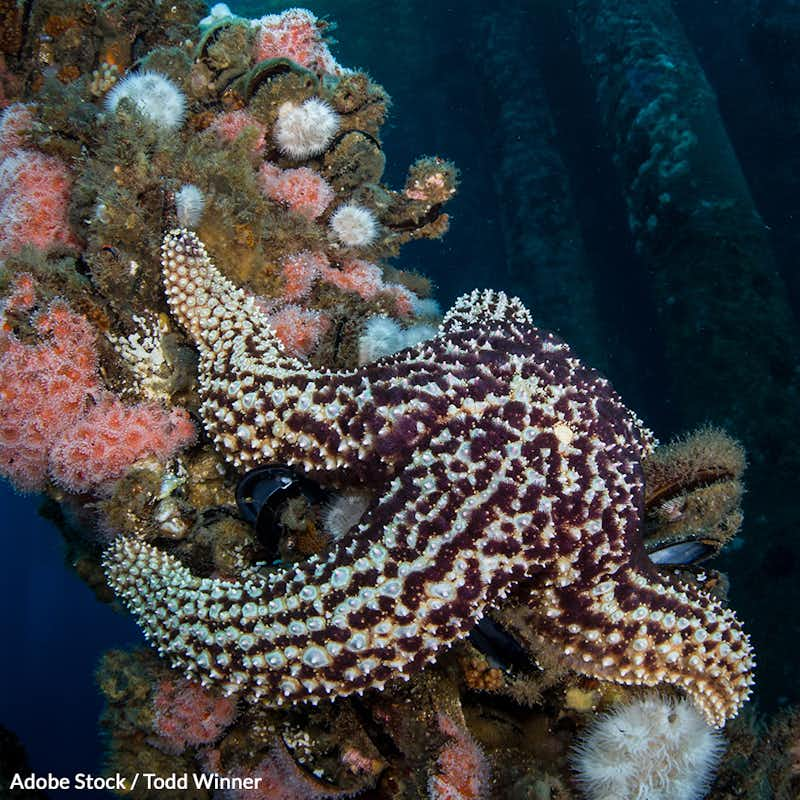Turn Old Oil Rigs Into Marine Habitats!
7,251 signatures toward our 50,000 Goal
Sponsor: The Rainforest Site
Decommissioning oil rigs costs millions and destroys thriving marine ecosystems. Repurpose them as reef habitat!

The Gulf of Mexico is home to more than 7,000 oil and gas platforms, some currently in use and some that have been removed1.
As they drain their reservoirs of fossil fuels below the sea, these rigs eventually become defunct and unprofitable.
The number of defunct rigs in the ocean is set to get bigger in the coming years. Removing them from the water is incredibly expensive and labor-intensive. Allowing them to rust and fall into disrepair is an environmental risk that could seriously damage marine ecosystems2.
These rigs are built to withstand hurricane force winds and the most turbulent of high seas, so removing and returning components of the rig to shore for recycling is a big job. Offshore installations consist of the equipment for oil and gas processing and drilling, and the supporting seabed-to-surface structure3. Decommissioning requires removing the ultra-heavy subsea support structure, steel frame, and the entire working core of the oil or gas rig, the drilling, production and processing modules, the helicopter deck and the accommodation for the crew4.
In the Gulf of Mexico, the Bureau of Safety and Environmental Enforcement's Rigs to Reefs program has seen 532 oil and gas platforms turned into artificial reefs for marine life5. After several years in the water, the structures have become covered by countless oysters, mussels, barnacles, sponges and corals, supporting even more crabs, worms and sea urchins to use. These animals then provide food for larger fishes, a true reef ecosystem3.
Reefing a platform is significantly less expensive than total removal and could save the industry millions of dollars each year. Some companies are spending the money they save on decommissioning on maintaining their existing platforms, marine conservation and education2.
Decommissioning destroys thriving marine ecosystems that have built up over decades. It also results in increased harmful air emissions, including greenhouse gas emissions, from the marine traffic required to conduct the removal works3. Decommissioning offers few social or economic benefits either. It creates few jobs and is ultimately a drain on taxpayer funds3.
As we face an ever worsening climate crisis, it's clear that burning fossil fuels and spills from drilling them have been driving our planet toward destruction for decades. Turning old oil rigs into ocean habitats will support life on Earth, rather than put it in danger.
Sign the petition below and ask the Bureau of Safety and Environmental Enforcement to make its Rigs to Reefs program a federal mandate for obsolescing oil rigs in all U.S. coastal waters.
- Mark Rowe, Geographical (28 February 2019), "Dossier: The terrifying cost of scrapping the world's ageing oil and gas rigs"
- Isabelle Gerretsen, BBC (26 January 2021), "The new use for abandoned oil rigs"
- Tom Baxter, The Conversation (5 October 2020), "Why we should leave old oil rigs in the sea - and why we don't"
- Paul Marks, BBC (5 August 2016), "What it takes to dismantle an oil rig"
- Bureau of Safety and Environmental Enforcement, "Rigs to Reefs."
The Petition:
To the director of the Bureau of Safety and Environmental Enforcement and Secretary of the Interior,
There are more than 7,000 oil and gas platforms located in the Gulf of Mexico, and each of them holds the potential to provide beneficial underwater habitat for marine life.
Oil and gas companies spend millions of taxpayer dollars on the costly and time consuming process of decommissioning their underproducing rigs. Decommissioning destroys thriving marine ecosystems that have built up over decades. It increases the threat of harmful air pollution, including greenhouse gas emissions, it creates few jobs and offers little social or economic benefit.
In contrast, reefing a platform is significantly less expensive than total removal and could save the industry millions of dollars each year. Along the Gulf of Mexico coast, some companies are spending the money they save on decommissioning on maintaining their existing platforms, marine conservation and education.
For some species, offshore rigs are even better nurseries than natural reefs. The towering pylons are the perfect spawning grounds for tiny fish larvae. Subsurface rigs provide the ideal skeleton for coral reefs, and can transform into the most bountiful human-made marine habitats in the world.
The Bureau of Safety and Environmental Enforcement's Rigs to Reefs program has successfully converted more than 550 platforms into reef habitat since 1984. After the Deepwater Horizon disaster, this program helped bring vibrant life back to the Gulf of Mexico, and it can do the same for old oil fields elsewhere.
I demand that the Bureau of Safety and Environmental Enforcement make its Rigs to Reefs program a federal mandate for obsolescing oil rigs in all U.S. coastal waters.
Sincerely,